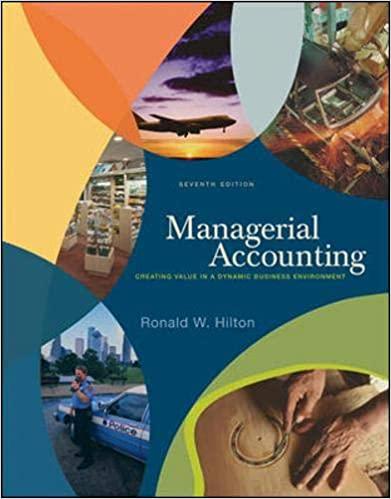Question
Student Brass Corporation manufactures brass musical instruments for use by high school students. The company uses a normal costing system, in which manufacturing overhead is
Student Brass Corporation manufactures brass musical instruments for use by high school students. The company uses a normal costing system, in which manufacturing overhead is applied on the basis of direct-labor hours. The companys budget for the current year included the following predictions.
| Budgeted total manufacturing overhead | $ | 446,600 | |
| Budgeted total direct-labor hours (based on practical capacity) | 20,300 | ||
During March, the firm worked on the following two production jobs: Job number T81, consisting of 74 trombones Job number C40, consisting of 110 cornets The events of March are described as follows:
- One thousand square feet of rolled brass sheet metal was purchased on account for $5,000.
- Three hundred pounds of brass tubing was purchased on account for $3,000.
- The following requisitions were submitted on March 5: Requisition number 112: 250 square feet of brass sheet metal at $5 per square foot (for Job number T81) Requisition number 113: 1,000 pounds of brass tubing, at $10 per pound (for Job number C40) Requisition number 114: 10 gallons of valve lubricant, at $10 per gallon All brass used in production is treated as direct material. Valve lubricant is an indirect material.
- An analysis of labor time cards revealed the following labor usage for March. Direct labor: Job number T81, 800 hours at $20 per hour Direct labor: Job number C40, 900 hours at $20 per hour Indirect labor: General factory cleanup, $5,000 Indirect labor: Factory supervisory salaries, $8,000
- Depreciation of the factory building and equipment during March amounted to $12,000.
- Rent paid in cash for warehouse space used during March was $1,200.
- Utility costs incurred during March amounted to $2,000. The invoices for these costs were received, but the bills were not paid in March.
- March property taxes on the factory were paid in cash, $2,400.
- The insurance cost covering factory operations for the month of March was $3,100. The insurance policy had been prepaid.
- The costs of salaries and fringe benefits for sales and administrative personnel paid in cash during March amounted to $9,000.
- Depreciation on administrative office equipment and space amounted to $5,000.
- Other selling and administrative expenses paid in cash during March amounted to $1,000.
- Job number T81 was completed on March 20.
- Half of the trombones in Job number T81 were sold on account during March for $700 each.
The March 1 balances in selected accounts are as follows:
| Cash | $ | 9,000 | |
| Accounts Receivable | 19,000 | ||
| Prepaid Insurance | 5,000 | ||
| Raw-Material Inventory | 149,000 | ||
| Manufacturing Supplies Inventory | 400 | ||
| Work-in-Process Inventory | 91,000 | ||
| Finished-Goods Inventory | 220,000 | ||
| Accumulated Depreciation: Buildings and Equipment | 100,000 | ||
| Accounts Payable | 12,000 | ||
| Wages Payable | 6,000 | ||
3. Complete the following T-accounts for the March transactions. Cash, Acc. Payable, Acc. Receivable, wages payable, prepaid insurance, accumulated depreciation buildings and equipment, manufacturing supplies inventory, manufacturing overhead, raw materials inventory, cost of goods sold, work In progress inventory, selling and admin expenses, finished goods inventory, sales revenue
Step by Step Solution
There are 3 Steps involved in it
Step: 1

Get Instant Access to Expert-Tailored Solutions
See step-by-step solutions with expert insights and AI powered tools for academic success
Step: 2

Step: 3

Ace Your Homework with AI
Get the answers you need in no time with our AI-driven, step-by-step assistance
Get Started


